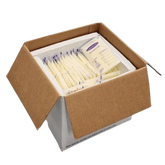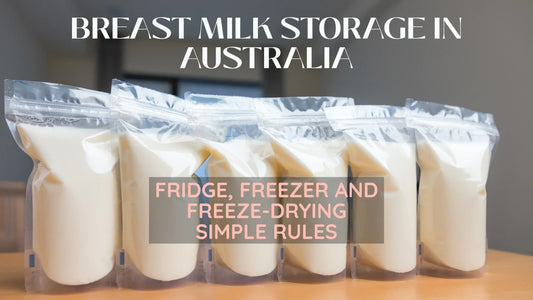Breastfeeding has been going well: your baby is thriving and happy. But now you are returning to work and feel sad at the prospect of weaning your baby.
Take heart, returning to paid work doesn’t mean you have to stop breastfeeding. Your baby can enjoy the health and nutritional benefits, and you will still have that unique connection through the one thing that only you can do for your baby - snuggling him close as he drinks your milk.
As well as keeping your baby healthy – so you won’t be using your sick leave to care for her –one very important factor for choosing to breastfeed when you return to work is the special connection you will have with your little one: However competent her carers are, breastfeeding is the one thing only you can do for your baby.
Real mums' stories:
Sarah, mother of a ten-month-old returned to work when her baby was five months old. She says,“ I remember stressing about having to express and what that would mean for me, how I would cope, if it was going to be easier to just stop breastfeeding. She says, “once I started work and got into a routine it was fine and I realised I was worried about nothing. We are still breastfeeding as much as ever.”
Cara, mother of a four-month-old started back at work last week. She says, “our company has a soft-landing policy, so I work from home in the morning and then go into the office at lunch. We have a nursery room so it’s pretty easy to pump in the office. The biggest challenge is finding time to pump so I schedule it in my diary and have even started walking out of meetings if I need to. I pump in the morning and then breastfeed my baby and head into the office around 12. She has two x 120mls bottles of expressed milk whilst I am gone and then feeds normally at night. The only trouble I have found is if I have a late meeting or work event but I have a nanny so I get her to bring her to me so I can feed her. Over the next few months, I will add an hour until I am back in the office full time.”
While Sarah and Cara make breastfeeding and employment seem relatively straight forward, for other women, facilities and circumstances in a workplace can be much less accommodating for breastfeeding women.
Hayley returned to work when her baby was 6months. She says, “when I asked the manager where I could express while I was at work, she said I was more than welcome to grab a stool and sit in the disabled toilets."
"I ended up expressing twice a day in my car the three days a week when I was at work. I wish I had told her it wasn’t appropriate to offer toilets as a place to express but I didn’t want to cause any issues with my job. It was a casual position, and I needed the money.”
Gaining support at work
Although legally in Australia, your right to breastfeed (or express at work) is protected by the federal Sex Discrimination Act, which prohibits discrimination on the basis of sex, marital status, pregnancy and potential pregnancy, an understanding employer and co-workers will make things a lot easier. If you feel less than assertive about requesting support at work, you can tell your employer that your paediatrician has prescribed breastfeeding for health reasons or to prevent allergic reactions (this isn’t necessarily untrue – your baby may develop health problems or allergies if he is fed formula). If your co-workers object to human milk in the office fridge (it has happened), store your milk inside a lunch box with your name on - they will be none the wiser!
Choosing a carer
To make breastfeeding and working possible from a practical perspective, it is important to choose a carer who is breastfeeding friendly: your carer will need to be motivated to implicitly follow your instructions to store and thaw (if necessary), or make up freeze-dried breast milk powder and feed your milk to your baby.
There is nothing worse than arriving with full breasts to pick up your baby, only to find she has just been fed, so do request that your carer considers this. She can either help your baby wait (as long as he isn’t upset) or offer a small amount of milk to ‘tide him over’ (rather than a full feed) if you are on your way home. This will also require close communication on your part – perhaps a call as you leave work with an estimated arrival time.
Expressing and returning to work
It is wise to start expressing about two weeks before you return to work. This will allow you to become efficient at expressing and store some milk in case you have some ‘low supply’ days when you are back at work. However, please don’t worry if this happens, breastfeeding according to your baby’s cues on your days off will boost your supply again.
What equipment do I need?
To maintain your milk supply, a good quality electric pump is an investment, especially if you buy or hire a pump which expresses both breasts at once as this will shorten the time required to express. Double pumping also stimulates milk production more effectively. You will need a private space to express and a fridge or eski with ice packs, as well as milk storage bags or containers to store your milk while you are at work.
How much milk does my baby need?
The research shows that from one to six months, breastfed babies take in an average of 750 - 800mls per day (intake doesn’t increase with age or size). This will vary between individual babies but a typical range of breast milk intake is from about 570 mils to 900 mls a day.
So, to estimate how much milk your baby will need each feed, work out about how many feeds your baby has in 24 hours then divide 800 mls by that number. For instance, if your baby has 6 feeds a day, you would make up feeds of 150 mls.
It would also be wise to leave some smaller amounts with your carer - say, about 30 to 50 mls, to offer as a top-up if your baby is thirsty or it is almost time for you to pick her up. Then she will still feed when you arrive and also, your carers won't waste precious expressed milk by starting another full bottle if your baby is a bit hungrier than usual.
Practically speaking…
At work, it can help to look at a picture of your baby or smell an article of his clothing as you express. You can also leave a worn article of your clothing with your baby, so although you aren’t physically present, he has your comforting smell close by as the carer offers a feed.
You may try using a wearable breast-pump for expressing at work and perhaps express as you drive to work (this could be tricky if you travel by public transport).
Besides expressing at work, other options to maintain a good milk supply include asking for some flexibility so that perhaps you work from home one day mid- week (and breastfeed as your baby needs) or either go to your baby or have him brought to you by his carer for a feed during your lunch break if this is practical. You will also need to take care that after a weekend of more frequent feeds you express for comfort to avoid engorgement and the possibility of developing mastitis.
Some mothers choose to feed their baby at pickup before heading home. Of course, this depends on your care arrangements and timing, but a breastfeed after work, however this works for you, is a special reconnecting time for you and your little one to look forward to.
Pinky McKay is an International Board-Certified Lactation Consultant and a mother of five breastfed children. She is also the best-selling author of ‘Sleeping Like a baby’, ‘ Parenting by Heart’ and ‘Toddler Tactics’ (Penguin Random House). Pinky is the creator of Boobie Foods – all natural Boobie Bikkies and 100% organic Boobie Teas made with safe, lactogenic ingredients to support breastfeeding mothers. Download her FREE ebooks ‘Making More Mummy Milk, Naturally’ and Prepare to Breastfeed Like a Boss (Before you have your baby) at www.boobiefoods.com.au







